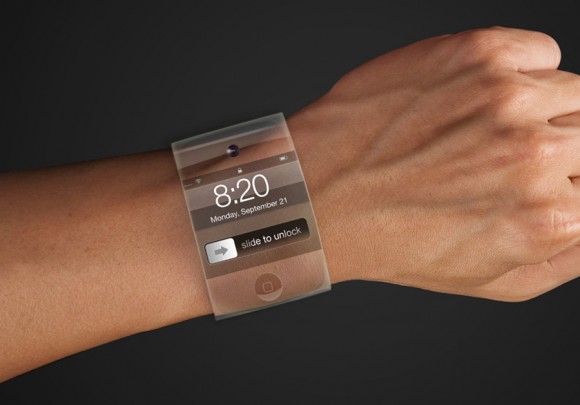 NEWS
NEWS
 NEWS
NEWS
 NEWS
NEWS
![]() New rumors have surfaced about Apple’s alleged iWatch, and if it’s true, we could be in for something quite radical when it comes to mobile computing.
New rumors have surfaced about Apple’s alleged iWatch, and if it’s true, we could be in for something quite radical when it comes to mobile computing.
Previous reports about the iWatch stated that the device will feature a curved touch sensor. Apple was recently awarded a patent for this design, which describes a technology that pertains to “depositing and patterning a conductive thin film on a flexible substrate to form at least one touch sensor pattern, while the flexible substrate is in a flat state.” Another feature said to be included in the iWatch comes from Apple’s acquisition of PrimeSense, a company that specializes in motion tracking technology.
We’ve yet to see a glimpse of what iWatch might actually look like, we don’t even know if the device has even been made, as the company is keeping tight-lipped about its wearable devices. Even so, sources familiar with the matter are claiming that the company is looking into equipping the device with technology that would enhance its battery life far beyond any similar gadget of its size.
According to a report from The New York Times, Apple is attempting to fit solar panels onto the device, or alternatively charge it wirelessly using magnetic induction, or else harness the power of kinetic charging (shaking something to charge it), a technology already present in some watches.
The need for enhanced battery life comes at a time when consumers are demanding more from their devices. Right now, we use our smartphones for multiple tasks – including communicating with others, getting reminders, playing games, watching videos, taking photos, chatting and so much more. Because of these intense activities, our devices’ battery cannot keep up with us, thus half way through the day, we find ourselves looking for somewhere to plug it in and get more juice. The problem with this is we can’t always find a place to plug in our device, or because we’re moving around, charging our device just isn’t an option.
According to Tony Fadell, the “Father of the iPod” and Nest co-founder, Apple has been experimenting with the idea of putting a smart battery inside its devices for years, but an adequate solution has yet been found. As stated earlier, Apple is looking into wireless charging, embedded solar panels, and even a “shake to charge” technology to enhance its devices’ battery life, but others are looking into other technologies to make them last longer.
Investors such as the Founders Fund, Yahoo CEO Marissa Mayer, and the Andreessen Horowitz firm are backing uBeam, a startup that’s trying to build a technology that involves piezoelectricity — a form of charge that is created through vibrations of certain crystals and ceramics – or simply put, pulling energy from the air.
“Battery technology advancements are lagging far behind advancements in mobile tech, while power consumption rate is increasing as consumers demand more from their devices,” said Meredith Perry, founder of uBeam.
“When wireless power is everywhere, battery life and charging rates will no longer be critical factors in mobile devices as our devices will always be charging,” Perry added.
Support our mission to keep content open and free by engaging with theCUBE community. Join theCUBE’s Alumni Trust Network, where technology leaders connect, share intelligence and create opportunities.
Founded by tech visionaries John Furrier and Dave Vellante, SiliconANGLE Media has built a dynamic ecosystem of industry-leading digital media brands that reach 15+ million elite tech professionals. Our new proprietary theCUBE AI Video Cloud is breaking ground in audience interaction, leveraging theCUBEai.com neural network to help technology companies make data-driven decisions and stay at the forefront of industry conversations.